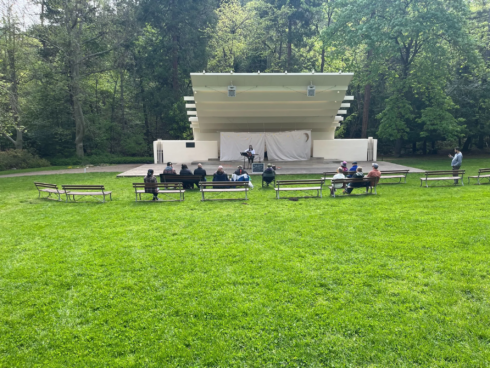Nearly 80 enthusiastic Ashland residents filled the Meese Room of the Hannon Library on Oct. 11, ready to address one of the most serious problems the city of Ashland has faced to date – deer.
Growing concerns regarding the city’s perceived deer problem have culminated in the first-ever citywide deer count in the state of Oregon, a volunteer effort to determine just how many deer reside within city limits. Tuesday’s meeting was a training session in preparation for the actual count, which was held on Thursday.
“You’re making history,” said Carol Voisin, Ashland city council member, impressing the gravity of the situation on the assembled volunteers.
“We’re gathering data that will provide information needed to understand our relationship with wildlife,” she added.
Between 7:30 a.m. and 8 a.m. on Thursday, Oct. 13, when deer are supposedly most active, volunteers went out to count the deer on their assigned transects. For the census, Ashland was divided into areas A through H, which were subdivided into a total of 63 transects for volunteers to walk. This allowed volunteers to cover approximately 90 percent of the city. Following the census was a debriefing at the Standing Stone Brewing Company, where about ten volunteers said they didn’t see any deer, while five said they spotted more than five deer. Jean Fyfe, a volunteer who covered the transect along Ridge Road and Terrance Street, spotted a whopping 28 deer.
Michael Parker, a professor of biology at Southern Oregon University and one of the project leaders, reported that with all the transects covered, a total of 187 deer were spotted in the half hour survey, with approximately 50 percent of the volunteers reporting no deer sightings.
Many of the volunteers had personal reasons for participating in the survey. Pat Fuhrman, a resident who recently returned to Ashland, said she participated “because I haven’t been able to have a garden since I moved back,” a problem she never had 15 years ago. Another volunteer and resident of Ashland at Tuesday’s meeting, Nick Viani, echoed her sentiment.
“Anyone attempting to grow food in a sustainable environment will feel the need to barricade the deer [out of their yards],” she said.
Some volunteers just wanted to find out the truth about the deer.
“People are perceiving a problem before it’s established that it is a problem,” said Terry and Wanda Nelson, both Ashland residents.
“People who have deer that maraud their rose bushes think it’s a big problem, but the people watching from their kitchen window don’t,” said Parker.
Whether or not it’s a problem remains to be seen, but hopefully this first count can start to address this issue.
“A huge problem is misinformation.” Parker stated. “People are annoyed but we just don’t know.”
The road leading to this week’s landmark count was a long one. According to Allan Peterson, a retired art professor and member of the group organizing the survey, a committee was formed two years ago to address the deer population and picked up momentum after Ashland Mayor John Stromberg called a meeting where community members voiced concerns on the topic.
The official findings are not expected until the January issue of the City Source, a monthly newsletter published by the city, but Terry Nelson commented that this survey “will bring real information as opposed to supposition.”
The information collected will be used with data collected every fall and spring, allowing for long-term observation and potential policy changes.
“We can’t respond without knowing how many deer we have,” Stromberg said. “This count may seem like a small step, but it’s leading Ashland in the right direction.”
Anyone interested in future censuses can e-mail deerashland@gmail.com, Stromberg encouraged.


